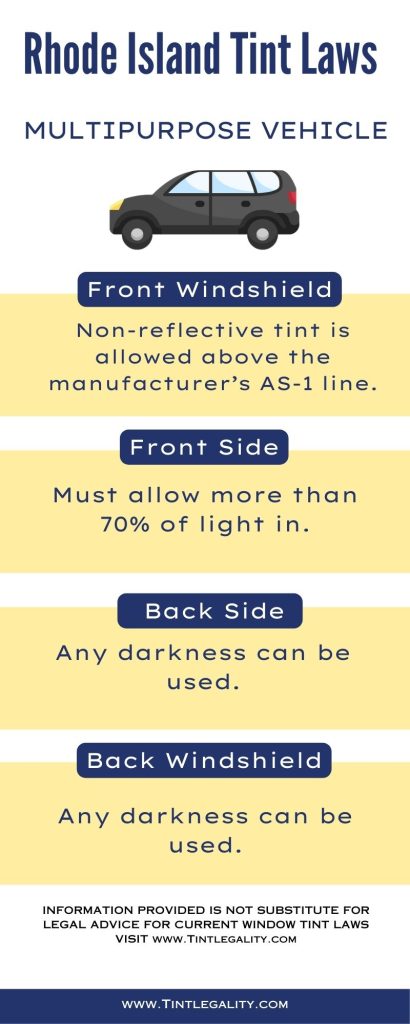Rhode Island tint laws were enacted in 2000, creating a firm legal framework for car window tinting in the state.
These laws provide crucial information about the allowable darkness and reflectiveness of car window tints, as well as additional rules and regulations that car owners should be familiar with.
Regulations Regarding Window Tint in Rhode Island
In Rhode Island, the percent of visible light allowed through your car windows is termed VLT: Visible Light Transmission.
The percentage of light permitted through your window film and glass varies for different types of vehicles.
Let’s break down these specifications.
| Vehicle Part | Sedans | SUVs and Vans |
|---|---|---|
| Windshield | Non-reflective tint above the AS-1 line | Non-reflective tint above the AS-1 line |
| Front Side Windows | More than 70% of light in | More than 70% of light in |
| Back Side Windows | More than 70% of light in | No restrictions |
| Rear Window | More than 70% of light in | No restrictions |
| Reflection | No restrictions | No restrictions |
| Medical Exemptions | Allowed | Allowed |
| Color Restrictions | No restrictions | No restrictions |
| Side Mirrors | No restrictions | No restrictions |
| Fines for Non-Compliance | First Conviction: $250, Higher for subsequent convictions | |
Windshield
Non-reflective tint is permissible above the manufacturer’s AS-1 line in both sedans and SUVs/vans.
This guideline is designed to prevent windshields from becoming overly dark or reflective, which could pose a hazard to drivers.
Front Side Windows
For sedans, SUVs, and vans, the front side windows must allow more than 70% of light in.
This requirement ensures that drivers have adequate visibility while driving, contributing to overall road safety.
Back Side Windows
Rhode Island’s tint laws differ for the back side windows depending on the vehicle type.
For sedans, the law stipulates that they must allow more than 70% of light, similar to the front side windows.
However, for SUVs and vans, there are no specified restrictions on the darkness of tint used.
Rear Window
Similar to back side windows, for sedans, rear windows must also let more than 70% of light through.
But again, for SUVs and vans, the state permits any level of tint darkness.


Additional Regulations
Rhode Island has further laws, rules, and regulations pertaining to window tinting.
The state places no restrictions on side mirrors, and there are no limitations on the colors of window tint permitted.
However, film manufacturers do need to certify the film they sell in Rhode Island.
Reflection
Reflection is a key aspect of window tint as it helps to reflect incoming light and reduce glare and heat.
For both sedans and SUVs or vans, Rhode Island law does not specify reflection restrictions.
This lack of restriction gives car owners a bit more flexibility in their choice of tint.
Medical Exemptions
Rhode Island also allows for medical exemptions to their standard tint laws.
For the specific terms of these exemptions, it is advisable to consult the state law directly.
Color Restrictions
When it comes to color restrictions, Rhode Island’s laws are quite permissive.
There are no restrictions on which window tint colors are allowed, providing vehicle owners with a wide range of aesthetic options.
Side Mirrors
There are also no restrictions on side mirrors under Rhode Island law.
This allows drivers to choose tint levels that align with their personal preferences and needs, without having to worry about legal ramifications.
Exceptions to Legal Limits
Exceptions to the legal limits of window tinting in Rhode Island are provided for medical reasons.
Such exemptions allow for darker tints than the state normally permits.
Penalties for Breaking the Law
The law takes non-compliance with these regulations seriously.
The penalties for contravening Rhode Island’s window tinting laws can include a fine of $250 per offense (§ 31-23.3-5).
Fines
The fines for breaking the window tint laws in Rhode Island are as follows:
- First Conviction: $250
- Second Conviction: Higher than the first, dependent on the judge’s discretion.
- Third Conviction: Even more substantial, again at the discretion of the judge.
Other Penalties
Beyond fines, drivers may also face additional penalties for non-compliance with the window tint laws.
These could include mandatory removal of the illegal tint, as well as potential points on the driver’s license, depending on the number of offenses.
Rhode Island’s tint laws are enforced to ensure the safety of all road users.
While these regulations may vary slightly depending on your county of residence, it is always advisable to consult with local DMV or law enforcement authorities for the most accurate and up-to-date information.
Rhode Island, the smallest state by area, is one of the most densely populated US states, and it’s important that its roads are as safe as possible.
By understanding and following these laws, residents contribute to the safety and well-being of all road users.
Compliance with Rhode Island’s window tint laws isn’t just a legal requirement – it’s a commitment to safety, consideration for other drivers, and a contribution to the overall well-being of Rhode Island’s road users. Stay safe, and enjoy the freedom that comes with adhering to the rules.
References:
https://en.wikipedia.org/wiki/Rhode_Island
http://webserver.rilin.state.ri.us/Statutes/TITLE31/31-23.3/INDEX.HTM